X-Band In-Line Coaxial-to-Groove Gap Waveguide Transition
Abstract
:1. Introduction
2. Groove Gap Waveguide Design
3. Transition Design
4. Tolerance Analysis
5. Conclusions
Author Contributions
Funding
Institutional Review Board Statement
Informed Consent Statement
Data Availability Statement
Conflicts of Interest
References
- Vincenti Gatti, R.; Rossi, R.; Dionigi, M.; Spigarelli, A. An x-band compact and low-profile waveguide magic-t. Int. J. RF Microw. Comput. Eng. 2019, 29, e21854. [Google Scholar] [CrossRef]
- Vincenti Gatti, R.; Rossi, R.; Dionigi, M. Wideband rectangular waveguide to substrate integrated waveguide (siw) e-plane t-junction. Electronics 2021, 10, 264. [Google Scholar] [CrossRef]
- Chen, Z.N.; Liu, D.; Nakano, H.; Qing, X.; Zwick, T. Handbook of Antenna Technologies; Springer: Singapore, 2016. [Google Scholar]
- Rajo-Iglesias, E.; Ferrando-Rocher, M.; Zaman, A.U. Gap waveguide technology for millimeter-wave antenna systems. IEEE Commun. Mag. 2018, 56, 14–20. [Google Scholar] [CrossRef] [Green Version]
- Vincenti Gatti, R.; Rossi, R. Wideband compact single-ridge waveguide to rectangular waveguide transitions with integrated E -plane bend. Electron. Lett. 2016, 52, 1699–1701. [Google Scholar] [CrossRef]
- Vincenti Gatti, R.; Rossi, R.; Dionigi, M. X-band right-angle coaxial-to-single ridge waveguide compact transition with capacitive coupling. Electron. Lett. 2019, 55, 103–105. [Google Scholar] [CrossRef]
- Vincenti Gatti, R.; Rossi, R.; Dionigi, M. In-line stepped ridge coaxial-to-rectangular waveguide transition with capacitive coupling. Int. J. RF Microw. Comput. Eng. 2018, 29, e21626. [Google Scholar] [CrossRef]
- Vincenti Gatti, R.; Rossi, R.; Dionigi, M. Broadband right-angle rectangular waveguide to substrate integrated waveguide transition with distributed impedance matching network. Appl. Sci. 2019, 9, 389. [Google Scholar] [CrossRef] [Green Version]
- Farahbakhsh, A.; Zarifi, D.; Zaman, A.U. 60-GHz groove gap waveguide based wideband h-plane power dividers and transitions: For use in high-gain slot array antenna. IEEE Trans. Microw. Theory Technol. 2017, 65, 4111–4121. [Google Scholar] [CrossRef] [Green Version]
- Ferrando-Rocher, M.; Sánchez-Escnderos, D.; Herranz-Herruzo, J.I.; Valero-Nogueira, A. Design of broadband gap waveguide transitions for millimeter-wave antenna arrays. In Proceedings of the 2018 15th European Radar Conference (EuRAD), Madrid, Spain, 26–28 September 2018; IEEE: Manhattan, NY, USA, 2018; pp. 501–504. [Google Scholar] [CrossRef]
- Cheng, X.; Liu, Z.; Yao, Y.; Yu, T.; Yu, J.; Chen, X. Novel band gap waveguide for low-loss and dual band applications. IEEE Trans. Microw. Theory Tech 2022, 70, 2610–2621. [Google Scholar] [CrossRef]
- Vosoogh, A.; Zaman, A.U.; Yang, J. Simple and broadband transition between rectangular waveguide and groove gap waveguide for mm-wave applications. In Proceedings of the 2018 IEEE International Symposium on Antennas and Propagation & USNC/URSI National Radio Science Meeting, Boston, MA, USA, 8–13 July 2018; IEEE: Manhattan, NY, USA, 2018; pp. 1101–1102. [Google Scholar] [CrossRef] [Green Version]
- Zarifi, D.; Ashrafian, A. A Broadband transition from microstrip to groove gap waveguide for ka-band applications. In Proceedings of the 2020 14th European Conference on Antennas and Propagation (EuCAP), Copenhagen, Denmark, 15–20 March 2020; IEEE: Manhattan, NY, USA, 2020. [Google Scholar] [CrossRef]
- Perez-Escudero, J.M.; Torres-Garcia, A.E.; Gonzalo, R.; Ederra, I. A Chebyshev transformer-based microstri-to-groove-gap-waveguide inline transition for mmic packaging. IEEE Trans. Compon. Packag. Manuf. Technol. 2019, 9, 1595–1602. [Google Scholar] [CrossRef] [Green Version]
- Shi, Y.; Zhang, J.; Zeng, S.; Zhou, M. Novel w-band millimeter-wave transition from microstrip line to groove gap waveguide for mmic integration and antenna application. IEEE Trans. Antennas Propag. 2018, 66, 3172–3176. [Google Scholar] [CrossRef]
- Nandi, U.; Zaman, A.U.; Vosoogh, A.; Yang, J. Novel millimeter wave transition from microstrip line to groove gap waveguide for mmic packaging and antenna integration. IEEE Microw. Wirel. Compon. Lett. 2017, 27, 691–693. [Google Scholar] [CrossRef] [Green Version]
- Rajo-Iglesias, E.; Kildal, P.-S. Numerical studies of bandwidth of parallel-plate cut-off realised by a bed of nails, corrugations and mushroom-type electromagnetic bandgap for use in gap waveguides. IET Microw. Antennas Propag. 2011, 5, 282–289. [Google Scholar] [CrossRef] [Green Version]
- Kildal, P.-S.; Zaman, A.; Rajo-Iglesias, E.; Alfonso, E.; Valero-Nogueira, A. Design and experimental verification of ridge gap waveguide in bed of nails for parallel-plate mode suppression. IET Microw. Antennas Propag. 2011, 5, 262–270. [Google Scholar] [CrossRef]
- Raza, H.; Yang, J.; Kildal, P.; Alfonso, E. Resemblance between gap waveguides and hollow waveguides. IET Microw. Antennas Propag. 2013, 7, 1221–1227. [Google Scholar] [CrossRef] [Green Version]
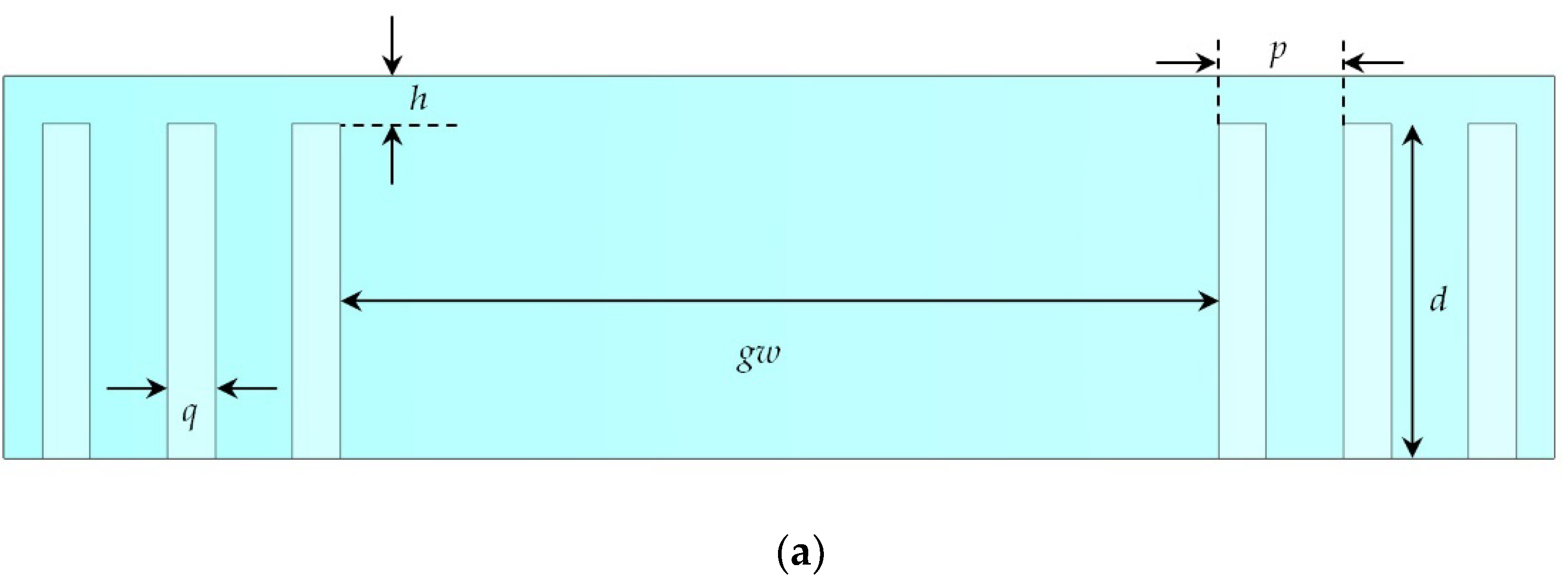
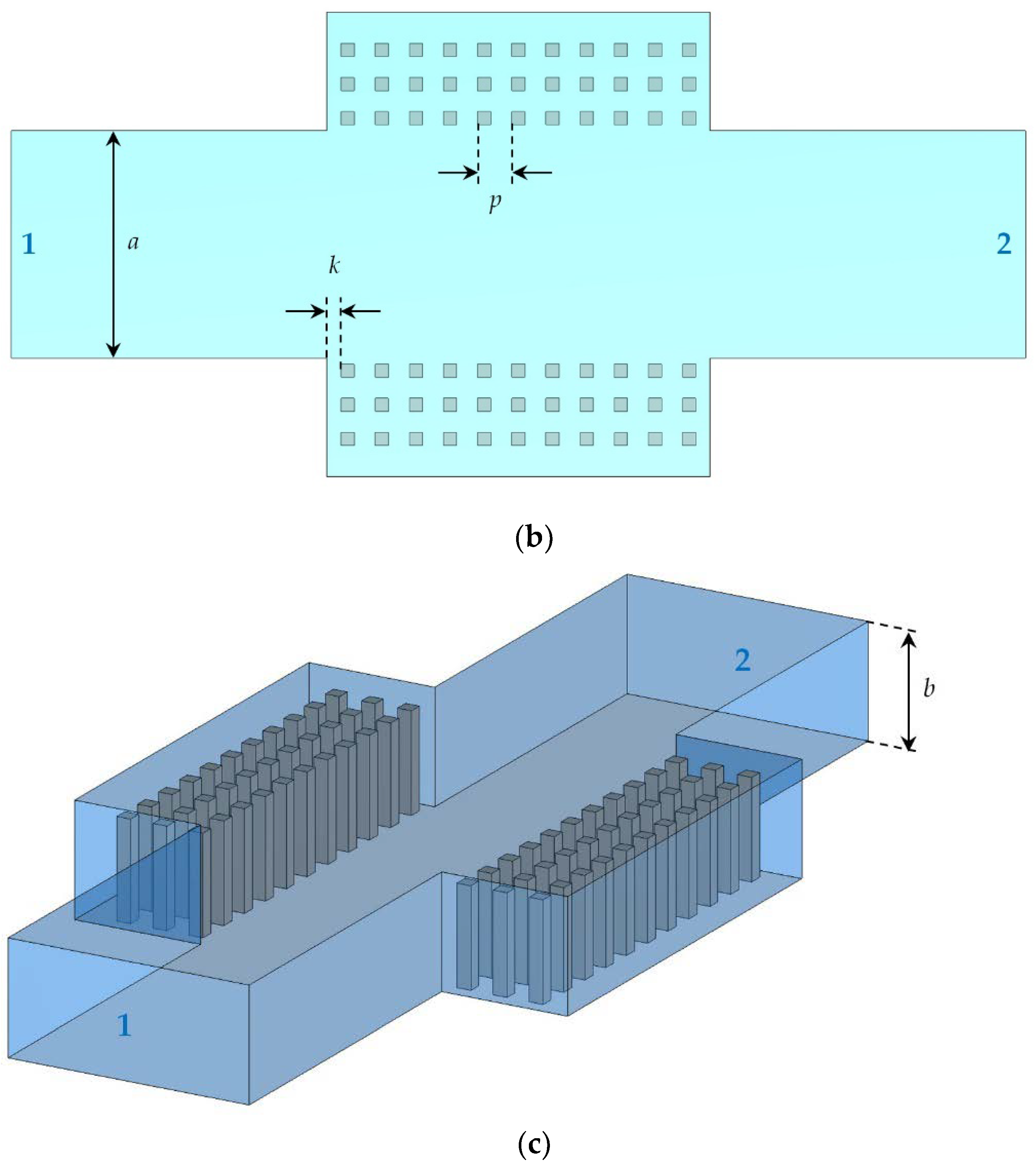
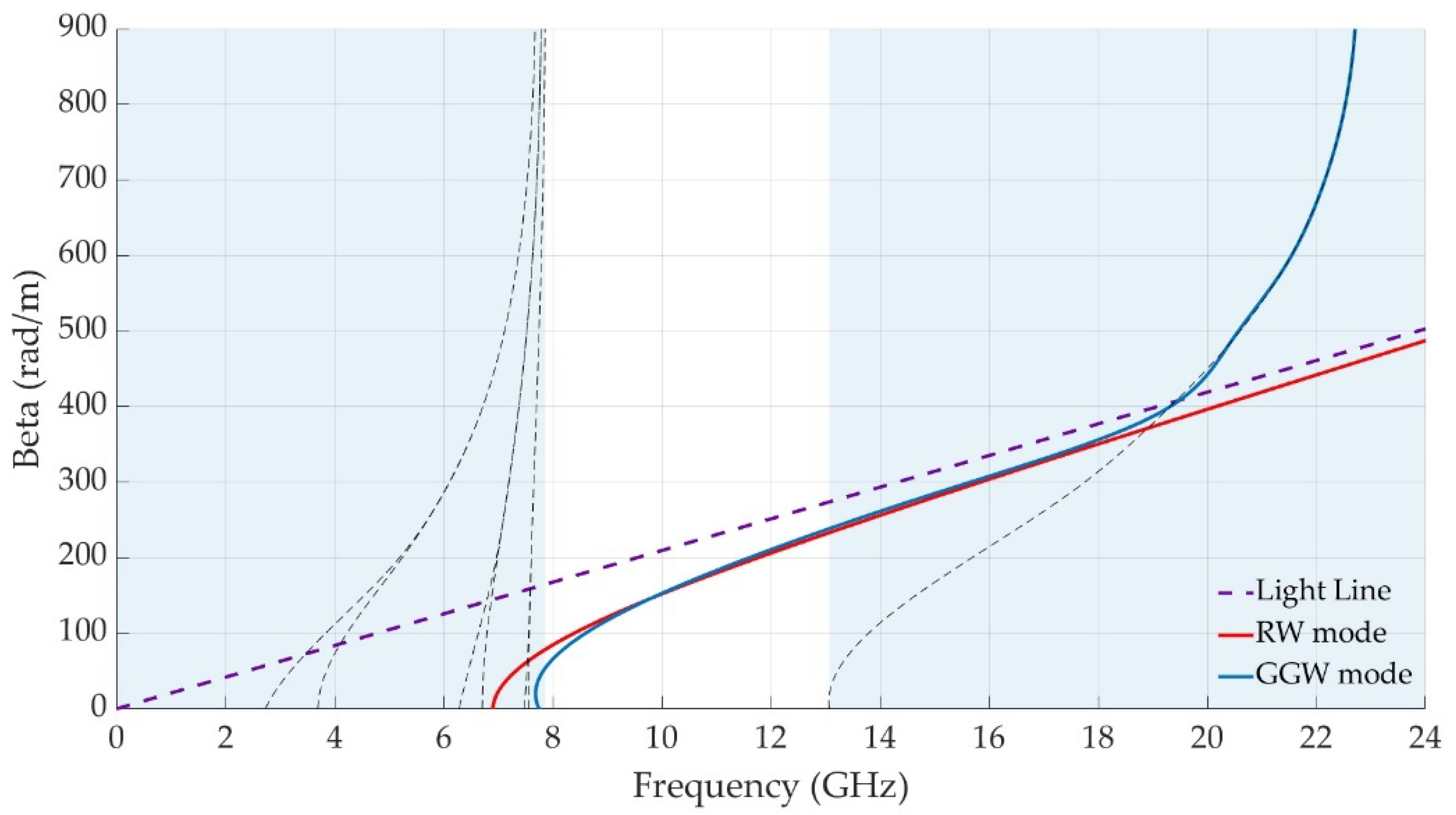
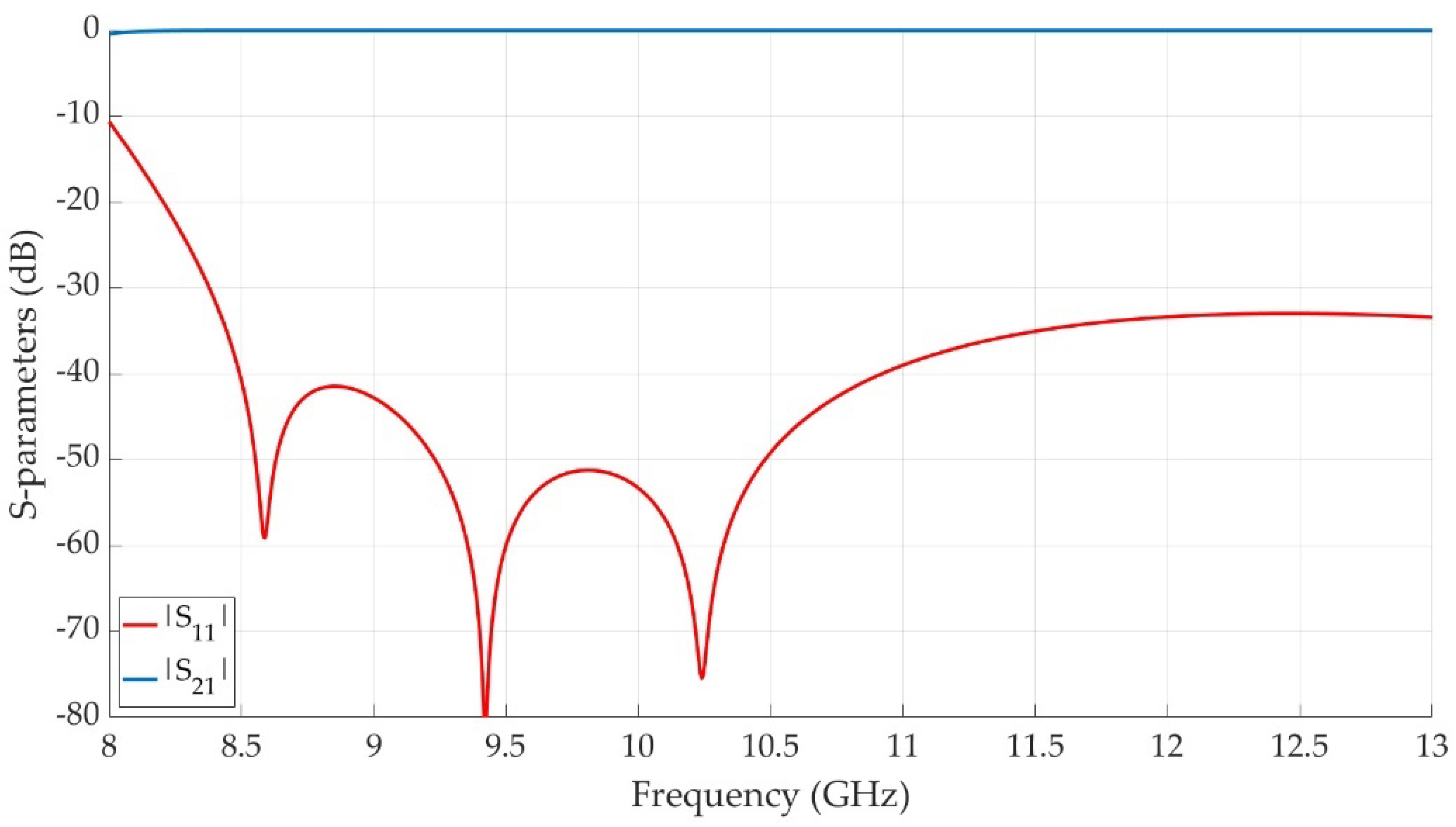
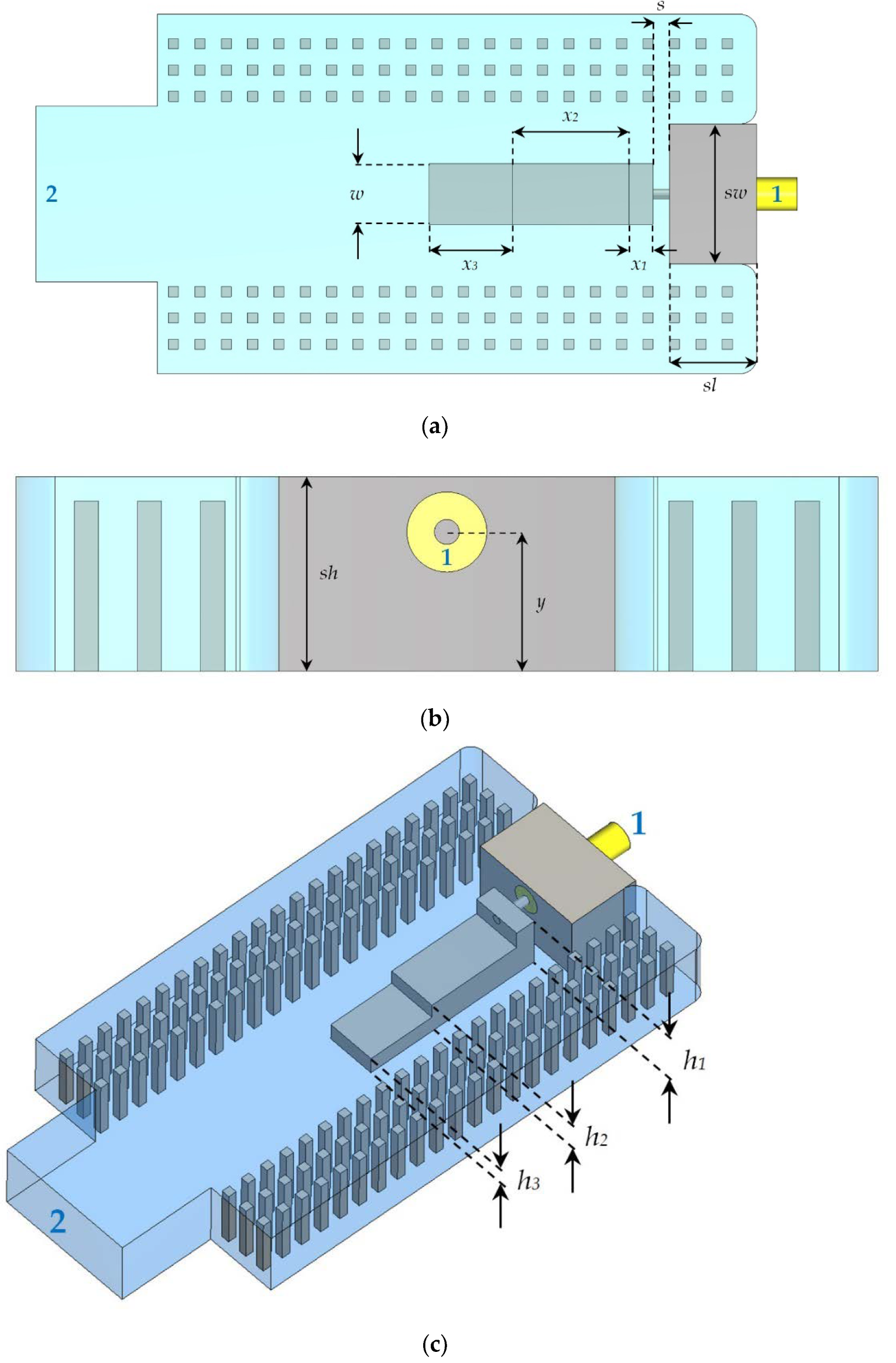


| Parameter | Description | Value (mm) |
|---|---|---|
| a | Eq. waveguide width | 21.70 |
| b | Eq. waveguide height | 10.00 |
| d | Pin height | 8.75 |
| gw | Groove width | 22.86 |
| h | Air gap separation | 1.25 |
| k | Eq. waveguide distance | 1.37 |
| p | Pin pitch | 3.25 |
| q | Pin side | 1.25 |
| Parameter | Description | NB Value (mm) | IB Value (mm) | WB Value (mm) |
|---|---|---|---|---|
| h1 | Step 1 height | 7.91 | 7.84 | 8.22 |
| h2 | Step 2 height | 3.22 | 16.06 | 5.23 |
| h3 | Step 3 height | - | 2.73 | 3.13 |
| h4 | Step 4 height | - | - | 1.65 |
| h5 | Step 5 height | - | - | 0.52 |
| s | Steps distance | 2.28 | 2.02 | 2.26 |
| sh | Short height | 10.00 | 10.00 | 10.00 |
| sl | Short length | 10.75 | 10.75 | 10.75 |
| sw | Short width | 14.84 | 17.29 | 13.82 |
| w | Steps width | 9.08 | 7.57 | 3.11 |
| x1 | Step 1 length | 17.42 | 2.98 | 3.15 |
| x2 | Step 2 length | 11.37 | 14.34 | 8.56 |
| x3 | Step 3 length | - | 10.30 | 11.46 |
| x4 | Step 4 length | - | - | 11.45 |
| x5 | Step 5 length | - | - | 13.36 |
| y | Coaxial height | 7.53 | 8.74 | 9.00 |
Publisher’s Note: MDPI stays neutral with regard to jurisdictional claims in published maps and institutional affiliations. |
© 2022 by the authors. Licensee MDPI, Basel, Switzerland. This article is an open access article distributed under the terms and conditions of the Creative Commons Attribution (CC BY) license (https://creativecommons.org/licenses/by/4.0/).
Share and Cite
Rossi, R.; Vincenti Gatti, R. X-Band In-Line Coaxial-to-Groove Gap Waveguide Transition. Electronics 2022, 11, 2361. https://doi.org/10.3390/electronics11152361
Rossi R, Vincenti Gatti R. X-Band In-Line Coaxial-to-Groove Gap Waveguide Transition. Electronics. 2022; 11(15):2361. https://doi.org/10.3390/electronics11152361
Chicago/Turabian StyleRossi, Riccardo, and Roberto Vincenti Gatti. 2022. "X-Band In-Line Coaxial-to-Groove Gap Waveguide Transition" Electronics 11, no. 15: 2361. https://doi.org/10.3390/electronics11152361







